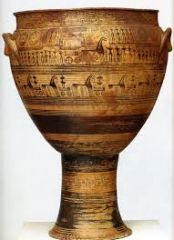![]()
![]()
![]()
Use LEFT and RIGHT arrow keys to navigate between flashcards;
Use UP and DOWN arrow keys to flip the card;
H to show hint;
A reads text to speech;
25 Cards in this Set
- Front
- Back
|
s |
Doric Order: Used for articulating the three units of the elevation of a classical building - the platform, the colonnade, and the superstructure (entablature). Echinus capitals with funnel-shaped echinuses, columns without bases and a frieze of triglyphs and metopes. 1:6 |
|
|
h |
Ionic Order: The Ionic order is characterized by, among other features, volutes, capitals, columns with bases and uninterrupted frieze. 1:8 |
|
|
n |
Capital: The uppermost member of a column, serving as a transition from the shaft to the lintel. |
|
|
g |
Frieze: The part of the entablature between the architrave and the cornice: |
|
|
j |
Pediment: In classical architecture, the triangular space (gable) at the end of a building, formed by the ends of the sloping roof above the colonnade: |
|
|
j |
Triglyph: A triple projecting, grooved member of a Doric frieze that alternates with metopes |
|
|
metope
|
The square panel between the triglyphs in a Doric frieze, often sculpted in relief
|
|
|
stylobate
|
the uppermost course of the platform of a classical Greek temple, which supports the columns.
|
|
|
volute
|
A spiral scoll-like form characteristic of the ancient Greek Ionic and the Roman Composite capital |
|
|
kouros
|
pl. kouroi |
|
|
kore
|
pl. korai
Greek "young woman" An Archaic Greek statue of a young woman |
|
|
peplos
|
A simple, long belted garment of wool worn by women in Ancient Greece
|
|
|
Archaic Smile
|
The smile that appears on all Archaik Greek statues from about 570 to 480 BCE.
The smile is the Archaic sculptor's way of indicating that the person portrayed is alive. |
|
|
caryatid
|
A female figure that functions as a supporting column
|
|
|
contrapposto |
The disposition of the human figure in which one part is turned in opposition to another part (usually hips and legs one way, shoulders and chest another), creating a counterpositioning of the body about its central axis. Sometimes called "weight shift" because the weight of the body tends to be thrown to one foot, creating tension on one side and relaxation on the other. |
|

Corinthian Order |
The Corinthian, with its offshoot the Composite, is stated to be the most ornate of the orders, characterized by slender fluted columns and elaborate capitals decorated with acanthus leaves and scrolls. |
|
|
acropolis
|
Greek, "high city"
In ancient Greece, usually the site of the city's most important temple(s) |
|
|
j |
k |
|

|
Dipylon Krater |
|
|
k |
Dipylon Amphora |
|
|
u |
Lefkandi Heroon |
|
|
i |
Lefkandi Centaur |
|
|
j |
Shrine Model at Argos |
|
|
r |
Dreros Temple |
|
|
j |
Dreros Statuettes |

